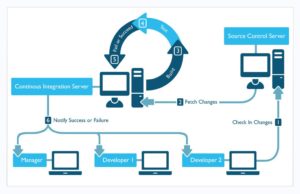CI or Continuous Integration is a term used in DevOps that allows real time integration of data into the central system of the organization. Earlier to this, integration of data took place once in a while by manual means and that made the organization less effective and deprived of real time developments.

The sole purpose of Continuous Integration is to create real time environment for the team members so that they can execute their work in a more efficient way than before. In continuous integration, the team members update their data into the central computer so that the rest folks can also have access to it. The difference between CI and other integration method is that it is real time and automated while the others are manual and are dependent on the team member for updating.
Making Continuous Integration Effective in Any Size Organization:
CI can be effective if it properly fits into the size organization. There must be proper analysis, feasibility check, and excellent management and only then CI will fit well with size organization. For making a good team organization, you need to have hardworking, punctual and innovative people in your team. The utmost important thing is that your team knows how to collaborate with their teammates. The proper collaboration of team members along with distinctive, proportional and well mined work distribution is the key trait of any best team organization. If you have such a team then CI will be effective automatically.
Some Advantages of Continuous Integration:
- Mitigating Risks: There’s a difference between your local working machine condition and the condition of that machine on which your product software will run. Sometimes it happens that the software which was working fine on your local machine works pathetically on your client’s computer. CI allows one to remove such problems by continuous testing and reexamining.
- Builds Confidence while Negotiating with Client: If you have an effective test suite tjhat sort outs all problems and error then the level of confidence inside you excels. Continuous testing removes errors, bugs and other small mistakes and makes your software more robust and secured and that will help you in taking a lead.
- Builds Better Communication making your work excellent: CI enhances communication level between your teammates and that helps in building the best software.
So if you want to build a software that has increased visibility, reduces overhead, mitigate risks, boosts confidence and makes your software effective and efficient then you should definitely try Continuous Integration.




